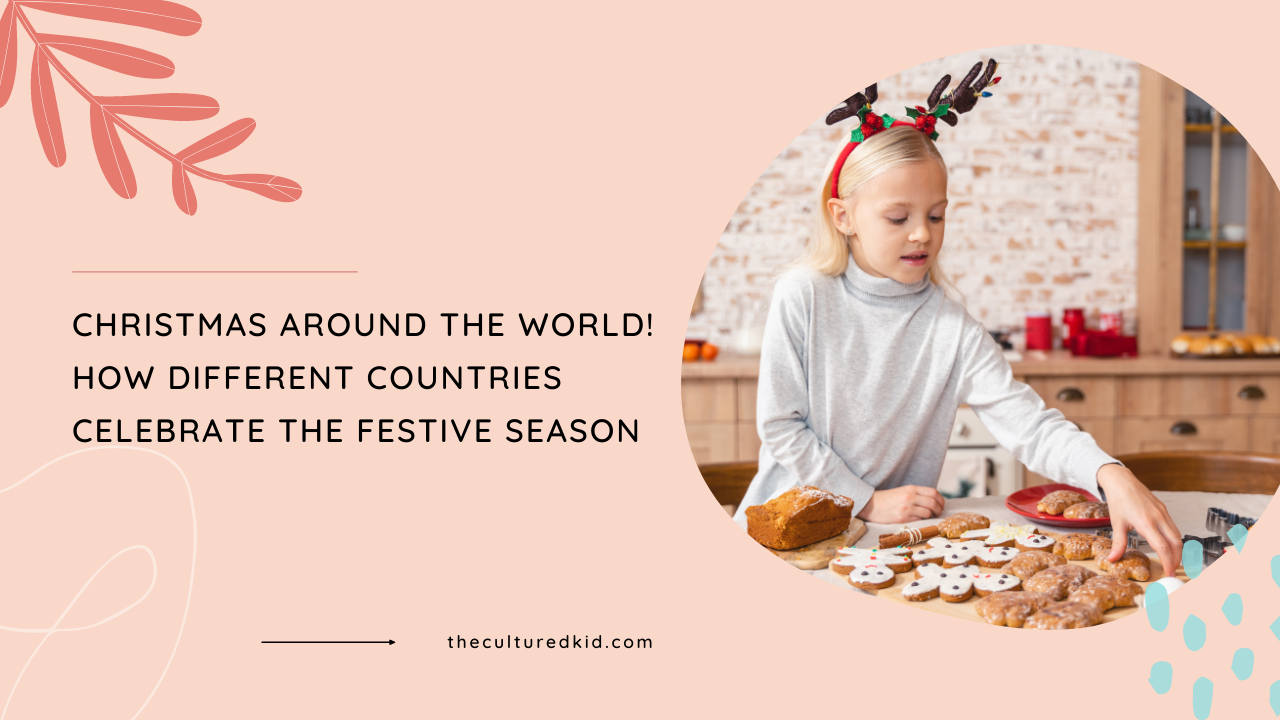CHRISTMAS AROUND THE WORLD | HOW DIFFERENT COUNTRIES CELEBRATE THE FESTIVE SEASON

We all have our favorite family tradition during Christmas. Whether it’s hanging a star at the top of the tree, or leaving some carrots out for Rudolph on Christmas Eve, but have you ever wondered how the rest of the world celebrates this much loved holiday?
With more than 2 billion people celebrating Christmas each year, today's post brings to life how the rest of the world celebrate in their own unique ways. We may just adopt a few new traditions for ourselves this year!
1. Serbia
Tradition: Tying up mum and dad
Here it’s not tradition to give presents at Christmas, but on the Sundays before. Two Sundays before 25 December, the children tie up their mum. She then has to pay a ransom in the form of gifts to be free. The following Sunday the same happens with dad.
2. Germany
Tradition: Santa’s spooky helper
As a part of celebrations in Germany as well as Austria and some parts of Switzerland, St Nikolaus (the saint on whom many countries base Santa Claus) is accompanied by a scary devil-like character as a warning to children no to be bad. In France, there’s a similar figure called La Pere Fouettard.
3. Italy
Tradition: Presents on a broomstick
A good witch called La Befana delivers children’s presents on January 6th using a broomstick rather than a sleigh. But if you’ve been bad – expect lumps of coal.
4. Netherlands
Tradition: Sinterklaas and Black Peter
In Holland, Santa Claus is called Sinterklaas. He doesn’t live at the North Pole, but in sunny Spain and arrives by steamboat with a helper called Black Peter rather than an elf.
5. Scandinavia
Tradition: Porridge instead of cookies and carrots
Across the region, a gnome-like character – called Tomte in Sweden and Nisse in Norway – is believed to protect barns and brings presents too. Every Christmas the children leave a bowl of porridge out for him.
6. Spain
Tradition: A different sort of Christmas log
In the region of Catalonia, traditional Nativity scenes get a cheeky addition in the form of a character called the ‘caganer’. And there’s no polite way to say this – the figure is squatting as if going to the toilet. Sometimes they are shepherds, but can even be footballers or politicians.
7. Australia
Tradition: Rudolph the red-nosed Kangaroo
Of course Down Under Christmas falls in summer. Their tradition has it that Father Christmas swaps his reindeer for ‘six white boomers’ or kangaroos. It’s also traditional to enjoy a barbecue on the beach on the big day.
8. India
Tradition: Decorating mango trees
For Christians on the sub-continent fir trees aren’t common. Instead mango trees are often decorated instead and mango leaves used to brighten up homes.
9. Greenland
Tradition: Rotting bird feast
The hardy folk in the Arctic Circle tuck into some unusual dishes. Kiviak is decomposed bird that has been wrapped in sealskin and buried under a stone for several months. They also feast on mattak, slices of raw whale skin.
10. Ukraine
Tradition: Spider webs on the tree
It may sound more like a Halloween tradition than a Christmas one but Ukrainians decorate their Christmas trees with spider webs. Legend says that a magic spider once visited a poor family at Christmas and turned the webs in their home into gold and silver.
11. Bulgaria
Tradition: Stick patting
One of the Christmas traditions is koleduvane involving boys singing carols outside neighbours’ houses then patting them on the back with decorated sticks.
12. Greece
Tradition: Basil and burning shoes
Basil is wrapped around a cross and used to sprinkle holy water around the house to ward off mischief making goblins called killantzaroi. It’s also traditional to burn old shoes for good luck in the following year.
13. Venezuela
Tradition: Roller-skating to Church
In the capital, Caracas, roads are closed off so that locals can blade to morning mass – they even tie pieces of string and dangle them out of the window so, if they oversleep, passers-by will be able to tug on the string and wake them up.
14. Brazil
Tradition: Presents in shoes
Brazilians celebrate the legend that animals gain the power of speech on Christmas night while children here get their presents in their shoes rather than stockings from Papa Noel.
15. Jamaica
Tradition: John Canoe parade
Christmas time is marked by the ‘John Canoe’ parade, which dates back to the times of slavery, where people dress up in wacky masks and costumes. Curried goat is often on the menu for Christmas dinner.
16. Mexico
Tradition: Carving radishes
In the run-up to Christmas time, the Festival Of The Radishes sees farming folk carve the vegetables into human figures, including those from nativity scenes.
17. Czech Republic
Tradition: The golden pig
Czechs are taught not to eat anything on Christmas Eve until a special dinner is served so that they can try and see a mystical ‘golden pig’ appear. Another tradition sees a girl putting a cherry twig in water on December 4th. If it blossoms before Christmas Eve the girl will marry the following year.
18. Poland
Tradition: Iron under the table
The main meal is on Christmas Eve. Poles place a piece of iron under the Christmas dinner table to make sure everyone has strong legs. The table legs have to be strong too – there are traditionally 12 courses, two of which are carp.
19. Iceland
Tradition: 13 Santas
There are 13 Santas in Iceland. These Yule lads, more troll-like than our traditional Father Christmas, traditionally come down from the mountain one by one during the days of the festive period leaving presents or rotten potatoes depending on the child’s behaviour. They have names like Door Sniffer and Meat Hook.
article via The Huffington Post

✨ Psst... When you're ready, here are a few ways I can help you get started with teaching your kids a foreign language at home...
1. Download my free 10 Page Guide for Parents to help you see how easy introducing a foreign language at home can be - especially if you don't speak the language at all.
2. Want a plan to run consistent language lessons that are fun and easy?
Access your first week of play based foreign language lessons for FREE here, all that's left is to select your language + start today!
3. Looking for a 12 month, step-by-step plan and play based resources to help you introduce a language to your little ones with EASE? Quit scrolling on Pinterest and Join our 12 Month Annual Lesson Bundles to get everything you need to started and KEEP GOING!
GRAB OUR FREE 'KIDS LANGUAGES MADE EASY' GUIDE
FOR NON-NATIVE PARENTS!
Discover how you can run consistent language lessons, that are fun and engaging and help your kids make the progress they deserve!
Even if you're not fluent!
We hate SPAM. We will never sell your information, for any reason.









